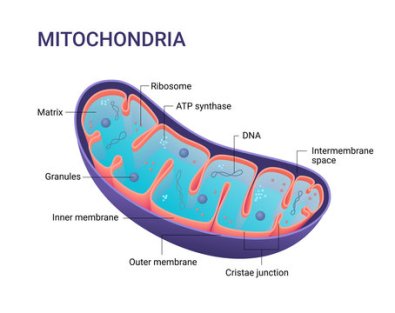
Mitochondria are cellular powerhouses. The trillions of cells that comprise our body tissues run on the energy created by them. They make energy for cells from the chemical energy stored in the foods we eat. They are found in almost every cell in our bodies. Energy from Carbohydrates, Fats and Proteins are converted to ATP which is the only energy source our bodies can use. Production of ATP is a complex process and is carried out in the inner membrane of the Mitochodria, a chain on the inner mitochondrial membrane known as the respiratory chain transfers energy (in the form of an electron) along several proteins until it becomes ATP.
An essential part of the process is NAD or Nicotinamide Adenine Dinucleotide which is a coenzyme involved in catabolic reactions as an electron carrier, it's main function is to accept a hydrogen atom, or proton, and is used in the electron transport chain to generate ATP.
As we age NAD levels decline which accellerates the ageing process.
Nicotinamide Mononucleotide or NMN is a NAD+ pre-cursor and NAD+ is an electron carrier of redox reactions in metabolism. NAD+ is the oxidised form of NADH.
Oxidisation is the loss of electrons while Reduction is the gain of electrons, hence Redox increases electrons.
Given the important role of NAD in increasing longevity or at least slowing down ageing, supplementation with NMN after the age of 35 should be considered the first step in halting or even reversing the ageing process.
Suggested doses of NMN range from between 500mg per day and 1g, the optimal dose is currently regarded as 600mg but my experience tells me to start low and build up over three to four days.
When NAD+ gets broken down, it creates nicotinamide and the body attaches a methyl to it to safely extract it through the kidneys. This means that as more NAD+ is used more methyl is needed to get rid of it, hence the need to take, in equal amounts, TMG supplements. (TriMethylGlycine)
In addition to energy production, Mitochondria play additional roles such as Autophagy and Apoptosis, the recyling of proteins and programmed cell death.
Apoptosis is the method used by the body to get rid of unwanted or abnormal cells, should this process be blocked it could give rise to cancer cells, so if any cell gets a mutation the Mitochondria instruct that cell to kill itself.
Autophagy is the process of reusing old and damaged cell parts. Proteins cannot function properly unless they are properly folded, and misfolded proteins create senescent cells, zombie cells that refuse to die which infect nearby healthy cells turning them into new senescent cells.
Maintaining the optimal functions of Mitochondria is therefore essential to healthy and prolonged life.
In conclusion of article 1 of this series, ATP is the only energy source our bodies can use and relies on NAD to transport the electron to generate ATP. Maintaining a healthy supply of NAD can be achieved through supplementation of NMN, which in turn needs TMG to help rid the body of a product of NAD, Nicotinamide.
Aside from it's main role of providing energy, Mitochondria play a vital role in the prevention of cancer and other diseases.
Any Longevity routine should pay attention to the production of NAD and enhance autophagy and apoptosis.
NAD precursors such as NMN, NR (nicotinamide riboside) and Niacin have been proven effective in raising NAD levels, but it's also been shown that levels decrease as we age due to an increase of a protein known as CD38, which devours NAD. Apigenin which is found in vegetables such as Parsley is effective in reducing CD38 Levels but supplements are prefered as you would have to eat too much Parsley to get the required amount.
Exercise and intermittent fasting...leaving 12 to 18 hours between meals are also effective ways of increasing NAD levels.
TMG should be taken in equal amounts to your chosen pre-cursor.
In article two we will be exploring the mitochondria in more detail and will learn about the antegrade axis and retrograde axis and the importance of cross-talk between them.
We will be looking at the importance of further supplementation, and in part three we aim to provide a supplementation regime.